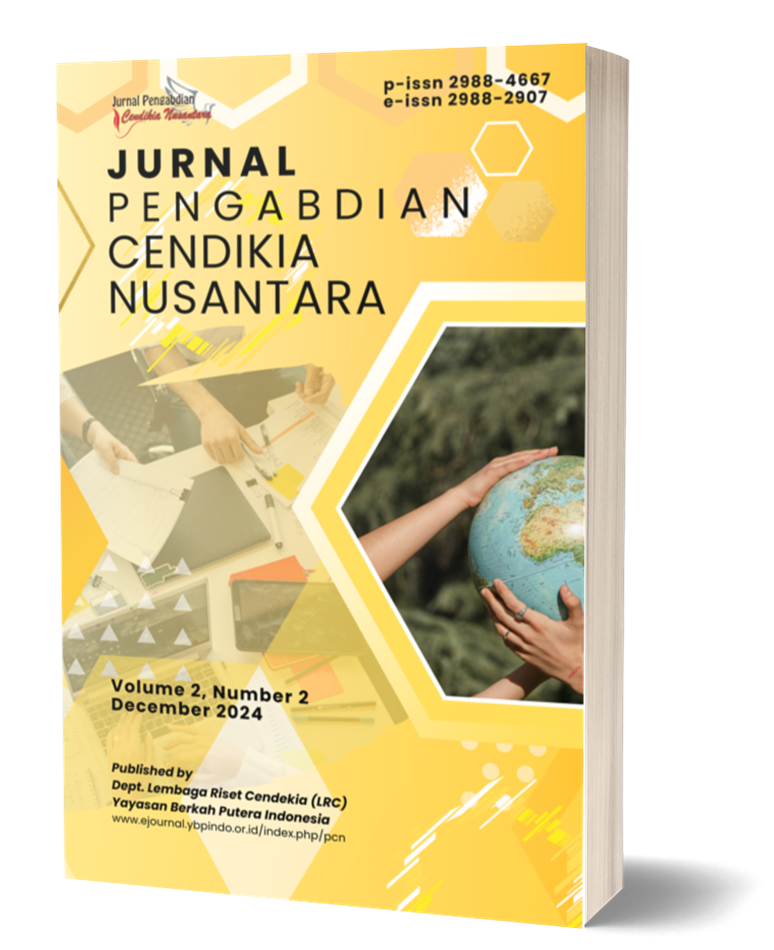Training on Making Liquid Dish Soap for Housewives in Bukit Nobita, Kampung Jua Village, Lubuk Begalung District, Padang City
DOI:
https://doi.org/10.70104/pcn.v2i2.105Keywords:
Training, liquid dish soapAbstract
The demand for liquid dishwashing soap has increased as some people have transitioned from using cream-based dishwashing soap to liquid dishwashing soap. Additionally, liquid dishwashing soap is easier to use and more effective in removing stains from kitchen utensils. The main ingredient of liquid dishwashing soap is the chemical compound surfactant, which functions to remove stains from kitchen utensils. The purpose of this community service activity is to provide knowledge to housewives on making liquid dishwashing soap to improve family economy and save household expenses. The methods used in this community service activity include discussions, presentations, knowledge sharing, and hands-on practice in making liquid dishwashing soap. The outcome of this community service activity is a finished product of liquid dishwashing soap made according to the methods provided.
References
Asnani, A., Eva, V. Y. D., dan Hartiwi, D., 2019, Transfer Teknologi Produksi Natural Soap Base Untuk Kreasi Sabun Suvenir, Jurnal Pengabdian Kepada Masyarakat (Indonesian Journal of Community Engagement)., 4(2),129.
Rahayuningsih et al. 2024. Program Pelatihan Pembuatan Sabun Cair Pencuci Piring untuk Ibu-Ibu PKK di Kelurahan Sungai Jering, Kecamatan Kuantan Tengah, Kabupaten Kuantan Singingi Jurnal Pengabdian Cendikia Nusantara, 2(1), pp. 35-40
Hambali, E., Bunasor, T. K., Suryani, A., dan Angga, K. G., 2005, Aplikasi Dietanolamida Dari Asam Laurat Minyak Inti Sawit Pada Pembuatan Sabun Transparan, Journal of Agroindustrial Technology.,15(2), 46–53.
Kiswandono, A. A., Nurhasanah, dan Akmal, J., 2020, Workshop Peningkatan Kemampuan Pembuatan Detergen Cair Sebagai Upaya Mengaktifkan Pengurus PKKDesa Fajar Baru, Aptekmas: Jurnal Pengabdian kepada Masyarakat, Politeknik Negeri Sriwijaya.
Mabrouk, S. T., 2005, Making Usable, Quality Opaque or Transparent Soap, Journal of Chemical Education., 82(10), 1534–37.
Dinastuti, R., Agung, A. K., dan Siti, F., 2021, Formula Sabun Susu Sapi Dengan Penambahan Ekstrak Daun Cengkeh. Analit: Analytical and Environmental Chemistry., 6(01).
Sari, V. I., 2010, Pemanfaatan Stearin Dalam Proses Pembuatan Sabun Mandi Padat. Jurnal Sagu 11.1.
Fatimah, S., Ulfa, N. M., Agung, A. K., 2021, Formula Sabun Susu Sapi Dengan Penambahan Ekstrak Daun Cengkeh. Analit: Analytical and Environmental Chemistry., 6(01).
SNI 3588-2017., 2017, Standar Mutu Sabun Cair, BSN.
Watkinson, C, 2000, Liquid Soap Cleaning Up Share, Inform 11, Champaign, AOCS Press.
Wijana, S., Sumarjo dan Harnawi, T., 2009, Studi pembuatan sabun mandi cair dari daur ulang minyak goreng bekas (Kajian pengaruh lama pengadukan dan rasio air: sabun terhadap kualitas). Jurnal Teknologi Pertanian, 10(1):54-61.
Zulkifli, M., dan Estiasih., 2014, Sabun dari Distilat Asam Lemak Minyak Sawit. Jurnal Pangan dan Agroindustri. 2 (4):170-177
Downloads
Published
How to Cite
Issue
Section
License
Copyright (c) 2024 Jumriana Rahayuningsih, Yoni Arita Taher, Inawati Sidabalok

This work is licensed under a Creative Commons Attribution-NonCommercial-ShareAlike 4.0 International License.








